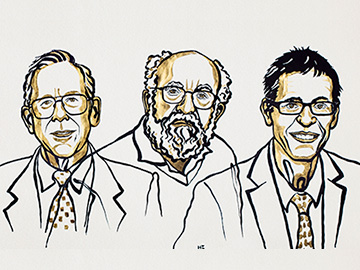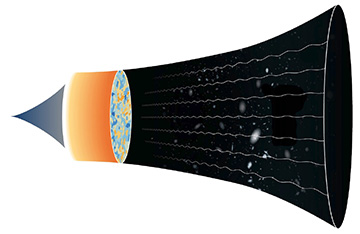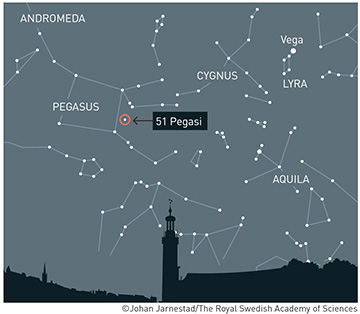
James Peebles, Michel Mayor and Didier Queloz, the 2019 Nobel laureates in physics. [Illustration: Niklas Elmehed / © Nobel Media]
This year, the Royal Swedish Academy of Sciences awarded the Nobel Prize in Physics to two strands of work spanning the theoretical and observational sides of understanding the universe.
Half of the prize went to James Peebles of Princeton University, USA, for a half-century of modeling and numerical work that helped to put theoretical flesh and bones onto observational data such as the Cosmic Microwave Background (CMB) of the Big Bang, and to give rise to the modern discipline of physical cosmology. The other half will be shared equally between Michel Mayor of the University of Geneva, Switzerland, and Didier Queloz of the University of Geneva and of Cambridge University, U.K., for their discovery, published in 1995, of the first exoplanet orbiting a solar-type star—a discovery that hinged on some novel optical design.
Peebles: Understanding the CMB
Peebles’ first major contribution to cosmology was published in the 7 May 1965 issue of Astrophysical Journal Letters—the same issue that included the celebrated publication by future Nobel laureates Arnold Penzias and Robert Wilson of the discovery of what came to be called the CMB. In a landmark paper, Peebles, as part of a team led by Robert Dicke, derived the likely properties of the CMB from first principles, and discussed its implications for the thermal history of the universe and the amount of baryonic matter it contained.
Peebles followed this up with another contribution in the same year on the blackbody radiation content of the universe that the Nobel committee cited, along with work by the Russian cosmologist Yakov Zeldovich, as “the starting point of physical cosmology.”
Limning out dark matter and energy
Present at the birth of the discipline, Peebles has also been a major figure in nurturing it to maturity. In a theoretical paper in 1982 on so-called cold dark matter, for example, he predicted the specific temperature anisotropy of the CMB. His prediction was later borne out in the observations of the Cosmic Background Explorer (COBE) spacecraft a number of years later (which snagged a Nobel Prize for OSA Honorary Member John Mather and George Smoot).

Artist's rendering of a timeline of the universe, from an unknown origin on the left to an exapnding and darkening future on the right. [Illustration: ©Johan Jarnestad/The Royal Swedish Academy of Sciences]
Two years later, in a paper in 1984, Peebles suggested that the so-called cosmological constant—the notorious “fudge factor” of general relativity that had previously been seen as discredited—could actually help explain the large-scale structure of the universe. Once again, his theoretical finding was borne out in later observational (and Nobel Prize–winning) work confirming the accelerating expansion of the universe.
Peebles’ theoretical work, coupled with other observational and theoretical studies, established the modern view of a cosmos in which only 5% of the universe’s observed energy density is in the form of “ordinary,” baryonic matter. The vast majority, instead, remains out of view, with 26% comprising elusive dark matter, and 69% the even weirder “dark energy” component tied to the cosmological constant. These concepts, as their names imply, are still shrouded in mystery—but the mathematical foundations laid by Peebles have helped to light the path.
Mayor and Queloz: Optical design sparks discovery
Whereas Peebles’ contribution was in the realm of theory and modeling, the work honored in the other half of the 2019 Physics prize, by Michel Mayor and Didier Queloz, had a decidedly observational bent. And it hinged on some clever optical design to obtain the right instrument for the task at hand.
While scientists had begun looking for exoplanets—or “stellar companions”—orbiting solar-type stars in the early 1980s, the task was a daunting one for the instruments that existed at the time. One key strategy was the so-called radial-velocity method, in which the Doppler shift of light coming from the star, red- or blue-shifted by the gravitational tug of the orbiting planet, could be read out in subtle time variations of the stellar spectra received on Earth. But figuring out how to measure those shifts—including what to use as a reference spectrum, and how to get the required precision—remained thorny problems.
In the early 1990s, Mayor, Queloz and colleagues developed an echelle spectrograph, the ELODIE, that was finally up to the job. The design departed from the common slit-and-absorption-cell geometry of other instruments, instead feeding light into an echelle grating via optical fiber and recording the spectra with a CCD camera. The sensitive and robust system reduced the required observation time and dramatically expanded the number of stellar objects on which precision Doppler spectroscopy, previously applicable only to bright nearby stars, could be used.
Exoplanet boom

In an observing campaign begun in late 1994, which used the ELODIE to survey unprecedented 142 stars, Mayor and Queloz zeroed in on the star 51 Pegasi, finding a periodic variation of just over four days in the star’s radial velocity. The data, subsequently analyzed in detail, pointed to a Jupiter-mass companion to 51 Pegasi.
The observation allowed the team to publish, in the 23 November 1995 issue of Nature, news of the first exoplanet orbiting a solar-type star. The discovery hit the astronomical community like a thunderbolt, spurring new observational methods for discovering exoplanets and entirely new models of the details of planet formation. As of now, in the wake particularly of the Kepler satellite and the current work of NASA’s Transiting Exoplanet Survey Satellite (TESS), more than 4,000 exoplanets have been discovered.
Of theory and observation
One interesting aspect of this year’s Physics prize was the way the Nobel committee honored both theoretical and observational science, under a rather broad umbrella: dicoveries shedding light on the mysteries of the universe. One of the newly minted laureates, Peebles, commented on precisely this point in a phone Q&A with journalists following the announcement.
“Theory in the natural sciences is empty without observations, in my opinion,” Peebles said. “The establishment that our universe is evolving was in part a theoretical discovery, but that was meaningless without the evidence—the very firm evidence now … We depend on that interaction of theory and observation.”
“We had a pretty good theory of how planets form—until the first extrasolar planet was discovered,” Peebles added, alluding to the work of the scientists with whom he shared the prize. “That’s a good illustration of the nature of science, isn’t it?”
